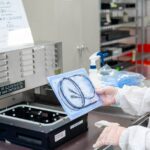For many innovators, the biggest challenge isn’t proving that their assay works—it’s getting that assay into a format that can survive the real world. Roadblocks to commercialization in point-of-care diagnostics often come down to things like reagent stability, packaging reliability, or scaling up production. At LSO, we’ve seen these issues surface time and again, and we’ve built practical ways to anticipate and solve them so our clients don’t lose time fighting the same battles twice.
Technical Roadblocks That Slow Commercialization
Reagent Stability
Reagent stability is usually the first hurdle. Sensitive chemistries don’t always play nicely with packaging. Alcohol-based solutions can evaporate, oxygen can degrade performance, and even light sensitivity can sneak in as a failure mode. It’s not unusual for a test that looks perfect on the bench to fail months later because of one of these factors.
Over the years, we’ve identified material sets that hold up against a wide range of reagents. For alcohol-based chemistries, we use combinations that extend shelf life. These solutions have been proven in production, which means we can apply them early in development to save time and reduce risk.
Activation & Dispensing
A blister isn’t just storage. In most point-of-care tests, it’s part of the mechanism itself. If a seal doesn’t break cleanly or the fluid doesn’t flow on cue, the whole assay can be compromised. We’ve seen plenty of designs fail because they worked in theory but couldn’t be manufactured in a way that delivered consistent activation.
To address this, we work with teams in two ways. Sometimes that means design-assist support—helping refine blister geometry and seal design so it’s manufacturable and reliable. Other times, when clients are further along, it means running formal verification and validation to prove performance under real-world conditions. Both paths draw on years of experience seeing where designs typically fail and building around those failure points from the start.
Scaling Up Packaging
A prototype is one thing. Building thousands—or millions—of blisters with the same reliability is another. Manual filling and sealing can get an idea off the ground, but those processes rarely translate to high-volume automation.
That’s why we put a tiered system in place to help programs grow without hitting a wall. Manual prototypes establish proof-of-concept, semi-automated flexible, hot-swappable lines handle pilot builds, and fully automated inline systems support true commercialization. Each stage feeds into the next, with tooling, process development, and validation designed to evolve smoothly. Work done at the prototype stage isn’t wasted when scaling—it becomes part of the foundation.
Program-Level Roadblocks Beyond the Lab
Materials and Supply Chain
Even if you solve stability and activation, you can run into trouble if your chosen materials aren’t viable long term. It’s not just about compatibility with the reagent. You need confidence that the material will be available in the right quantities years down the line.
That’s why we keep standardized material sets on hand that we know are compatible with challenging chemistries and are backed by stable supply chains. These sets have been proven in other programs, so clients aren’t starting from scratch or risking shortages when demand increases.
Regulatory Expectations
Reagent packaging is often underestimated in regulatory planning. In reality, it’s a critical part of the device that has to be validated, documented, and repeatable. ISO 13485 and FDA requirements don’t give much room for error.
At LSO, compliance is built into process development. When we design filling, forming, and sealing workflows, we validate them against regulatory expectations from the start. By the time a client is preparing for submission or inspection, the supporting data is already in place.
Scaling Production
Moving from pilot batches to commercial production is where weaknesses usually show up. A process that seemed solid at low volumes can suddenly expose flaws when scaled.
Because we run everything from prototypes to full automation under the same roof, we can spot these issues earlier and adapt before they become showstoppers. Clients don’t have to change vendors midstream or revalidate processes from scratch—continuity is built into the way we scale.
Why This Matters
After working with so many diagnostic innovators, we’ve seen most of the common roadblocks before. We’ve also developed what you might call “unofficial standards” for avoiding them—proven material sets, tiered scale-up pathways, and design frameworks that consistently work. These aren’t rigid checklists, but they give our clients a strong starting point. From there, we adapt the approach to fit their specific chemistry, device design, and commercial goals.
That combination—of experience, established frameworks, and willingness to dig into the details with each client—is what helps programs move forward with fewer surprises and stronger confidence.
Let’s Talk About Your Project
Roadblocks in point-of-care diagnostics don’t have to slow you down. Our team has already solved many of the challenges you’re likely to encounter—whether it’s reagent stability, packaging design, regulatory validation, or scaling production.
Tell us about your project today. Together, we can build a clear path from concept to commercialization without the setbacks that hold so many programs back.





